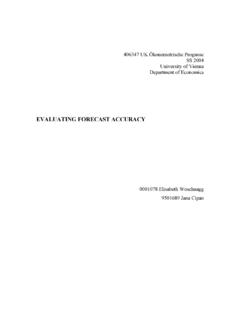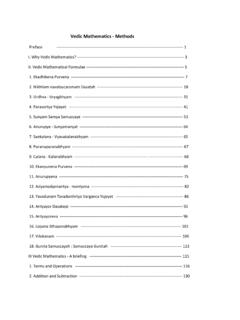Transcription of Dynamic Panel Data Models - Zentraler …
1 MotivationModelAlgebraEmpirical exampleConcluding remarksDynamic Panel data ModelsPeter LindnerJune 23, 2010 Peter LindnerDynamic Panel data ModelsMotivationModelAlgebraEmpirical exampleConcluding remarksContents1 Motivation2 ModelBasic set-upProblemSolution3 Algebra4 empirical example5 Concluding remarksLiteraturePeter LindnerDynamic Panel data ModelsMotivationModelAlgebraEmpirical exampleConcluding remarksMotivationMany economic issues are Dynamic by nature and use the paneldata structure to understand :Demand ( present demand depends on past demand) Dynamic wage equationEmployment modelsInvestment of firms; LindnerDynamic Panel data ModelsMotivationModelAlgebraEmpirical exampleConcluding remarksBasic set-upProblemSolutionOne way error component modelyit= yi,t 1+x it +uiti= 1.
2 ,N t= 1, ..,Twhereuit= i+ it iusual individual effects, when necessaryiid(0, 2 ) iusual error termiid(0, 2 )independent of each other and among themselvesPeter LindnerDynamic Panel data ModelsMotivationModelAlgebraEmpirical exampleConcluding remarksBasic set-upProblemSolutionOLSyitis correlated with i yi,t 1is also correlated with i= OLS is biased an inconsistent even if itare not seriallycorrelatedPeter LindnerDynamic Panel data ModelsMotivationModelAlgebraEmpirical exampleConcluding remarksBasic set-upProblemSolutionFixed effectsWithin transformation sweeps out i(yi,t 1 yi, 1), where yi, 1= Tt=2yi,t 1T 1is correlated with( it i.) FE estimator is biased, BUT consistent forT (notforN )Peter LindnerDynamic Panel data ModelsMotivationModelAlgebraEmpirical exampleConcluding remarksBasic set-upProblemSolutionRandom effectsQuasi-demeaning transforms the data to (yi,t 1 yi, 1) andaccordingly for the other terms(yi,t 1 yi, 1) is correlated with (uit ui.)
3 Because ,t 1which is correlated withyi,t 1 RE GLS estimator is biasedPeter LindnerDynamic Panel data ModelsMotivationModelAlgebraEmpirical exampleConcluding remarksBasic set-upProblemSolutionHow to deal with this problemThere are several ways in the literature, correcting for thebias, system GMM estimation techniques, of one approach: IV-estimationTake first differences to get rid of the individual effectsUse all the past information ofyitfor instrumentsand the structure of the error term to get consistent estimatesPeter LindnerDynamic Panel data ModelsMotivationModelAlgebraEmpirical exampleConcluding remarksDifferencing IModelyit= yi,t 1+uitFirst differenceyit yi,t 1= (yi,t 1 yi,t 2) + ( it i,t 1)First period we have observation on this model is periodt= 3, we haveyi3 yi,2= (yi,2 yi,1) + ( i3 i,2) yi1is not correlated with the error and a valid instrumentPeter LindnerDynamic Panel data ModelsMotivationModelAlgebraEmpirical exampleConcluding remarksDifferencing IIOne period forward we haveyi4 yi3= (yi3 yi2) + ( i4 i3)
4 Yi1andyi2are not correlated with the error and a validinstrumentOne more instrument for each of the following periodsDefine a matrix the contains all instruments of individualiWi= [yi1]0 00 [yi1,yi2] 0 [yi1, .. ,yi,T 2] All instruments in the model :W= [W 1,W 2, .. ,W N] Peter LindnerDynamic Panel data ModelsMotivationModelAlgebraEmpirical exampleConcluding remarksError termVariance-covariance matrix of the errorE[ vi v i] = 2 (IN G)whereG= 2 1 0 0 1 2 1 0 00 0 1 2 10 0 0 1 2 Since the instruments are orthogonal to the error we have themoment condition (used later for GMM)E[W i vi] = 0 Peter LindnerDynamic Panel data ModelsMotivationModelAlgebraEmpirical exampleConcluding remarksConsistent estimatesPre-multiplying the model with the matrix of all instrumentsgivesW y=W ( y 1) +W Performing GLS on this model gives the consistent one stepestimator (Arellano and Bond, 1991) 1=[( y 1) W(W (IN G)W) 1W ( y 1)] 1x[( y 1) W(W (IN G)W) 1W ( y)]
5 ]Peter LindnerDynamic Panel data ModelsMotivationModelAlgebraEmpirical exampleConcluding remarksOptimal GMM estimatesIt can be shown that the the optimal GMM estimator ( laHansen) for this model is the same formula except replacing(W (IN G)W)byVN=N i=1W i( vi)( vi) Wiwhere the vare obtain from the residuals form the aboveexplained estimationTwo step Arellano and Bond (1991) estimator is then 1=[( y 1) W( VN) 1W ( y 1)] 1x[( y 1) W( VN) 1W ( y)]Peter LindnerDynamic Panel data ModelsMotivationModelAlgebraEmpirical exampleConcluding remarksThe dataIllustration with Arellano-Bonds dataset (can be freely downloadedfrom the web)firm level employment (Arellano-Bond 1991:Some tests ofspecification for Panel data : Monte Carlo evidence and anapplication to employment equations, Review of EconomicStudies)
6 140 UK firmsannual data 1976-1984unbalancedPeter LindnerDynamic Panel data ModelsMotivationModelAlgebraEmpirical exampleConcluding remarksIdea behind the estimationsHiring and firing workers is costlyEmployment should adjust with delay to changes in factorssuch as capital stock, wages, and output demand and on thedifference between equilibrium employment level and the lastyears actual level Dynamic model where lags of the dependent variable are alsoregressorsPeter LindnerDynamic Panel data ModelsMotivationModelAlgebraEmpirical exampleConcluding remarksSummary StatisticsEmployment is at the firm level and output is at the industrylevel as a proxy for demandEstimations are done with the logarithm of the variablesTable:Summary StatisticsStatisticsEmployment Wage Capital : LindnerDynamic Panel data ModelsMotivationModelAlgebraEmpirical exampleConcluding remarksFirst naive approach - OLSS tata comand.
7 Reg n nL1 nL2 w wL1 k kL1 kL2 ys ysL1 ysL2 yr*Variable Coefficient (Std. Err.) ( ) ( ) ( ) ( ) ( ) ( ) ( ) ( ) ( ) ( )year dummies are not reportedPeter LindnerDynamic Panel data ModelsMotivationModelAlgebraEmpirical exampleConcluding remarksProblems with OLSL agged dependent variable is endogenous to fixed effects inthe error termEstimates are inconsistentOne can show that there is a positive correlation betweenregressor and error termThus it inflates the coefficient for lagged employment byattributing predictive power to it that belongs to the fixedeffectOne should expect the true estimate to be lowerPeter LindnerDynamic Panel data ModelsMotivationModelAlgebraEmpirical exampleConcluding remarksFixed effects: disregarding the Dynamic structureStata comand.
8 Xtreg n nL1 nL2 w wL1 k kL1 kL2 ys ysL1 ysL2 yr*, feVariableCoefficient (Std. Err.)L1 ( )L2 employment ( ) ( )L1 ( ) ( )L1 ( )L2 ( ) ( )L1 ( )L2 ( )year dummies are not reportedPeter LindnerDynamic Panel data ModelsMotivationModelAlgebraEmpirical exampleConcluding remarksProblems with Fixed Effects ModelPurging out the individual effects does not eliminate dynamicpanel bias, it essentially makes every observation oftransformed y* endogenous to the errorOne cannot use previous lags as instrumentsEstimates are now biased downwardsReasonable estimates should therefore lie between theseFE-and OLS estimates; between and LindnerDynamic Panel data ModelsMotivationModelAlgebraEmpirical exampleConcluding remarksArellano-Bond (difference GMM)Stata comand:xtabond2 n w L( ).
9 (k,ys) yr*, gmm( ) iv( L( ).(k,ys) yr*) nolevel robustVariableCoefficient (Std. Err.)L1 ( )L2 ( ) ( )L1 ( ) ( )L1 ( )L2 ( ) ( )L1 ( )L2 ( )year dummies are not reportedPeter LindnerDynamic Panel data ModelsMotivationModelAlgebraEmpirical exampleConcluding remarksProblems with Arellano-Bond I - ApplicationEstimate of lagged dependent variable is NOT in crediblerange between OLS and fixed effect estimatorProblem?Blundell and Bond 1998 do not expect wages and capital tobe strictly exogenous in our employment application Therefore one can instrument them tooPeter LindnerDynamic Panel data ModelsMotivationModelAlgebraEmpirical exampleConcluding remarksArellano-Bond with more instrumentsStata comand:xtabond2 n w L( ).
10 (k ys) yr*, gmm(L.(n w k))iv(L( ).ys yr*) nolevel robust smallVariableCoefficient (Std. Err.)L1 ( )L2 ( ) ( )L1 ( ) ( )L2 ( )L2 ( ) ( )L1 ( )L2 ( )year dummies are not reportedPeter LindnerDynamic Panel data ModelsMotivationModelAlgebraEmpirical exampleConcluding remarksProblems with Arellano-Bond II - GeneralNow the estimate is between the previously showed FE andOLS estimateBlundell and Bond (1998) show that difference GMM performsbad whenyis close to a random walk because untransformedlags are weak instruments for transformed of transforming the regressors it transforms theinstruments to make them exogenous to the fixed effectAdditional assumption that first differences of instruments areuncorrelated with fixed effects is LindnerDynamic Panel data ModelsMotivationModelAlgebraEmpirical exampleConcluding remarksArelano-Bond (system GMM) - one stepStata comand:xtabond2 n L( ).















